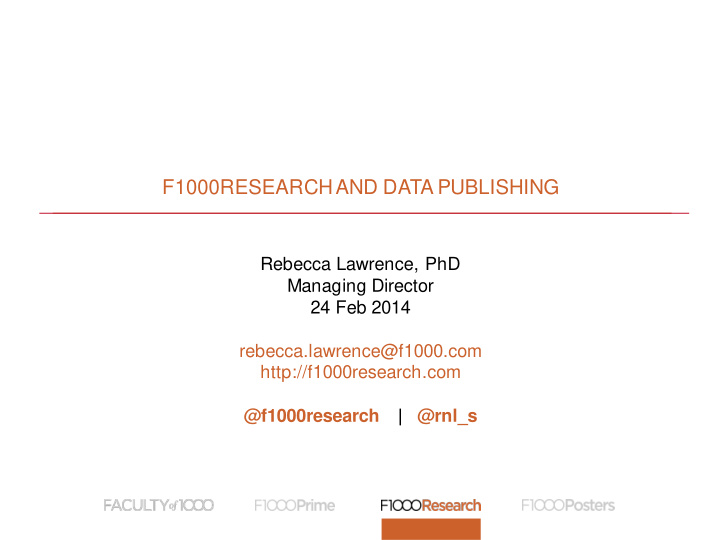



F1000RESEARCH AND DATA PUBLISHING Rebecca Lawrence, PhD Managing Director 24 Feb 2014 rebecca.lawrence@f1000.com http://f1000research.com @f1000research | @rnl_s
@rnl_s | @f1000research SUMMARY • F1000Research introduction • Data hosting • Data citation – a question • Data visualisation • Data peer review • Data metrics – a proposal
@rnl_s | @f1000research F1000 OVERVIEW F1000Posters F1000Prime Conference poster/slide repository Find recommended papers F1000Research Journal
@rnl_s | @f1000research F1000 RESEARCH : OPEN SCIENCE JOURNAL IN LIFE SCIENCES Inclusion of all data. Remove the publication delay. No restriction of access. Invited peer review (post-publication). All article types published. Transparent refereeing.
@rnl_s | @f1000research
@rnl_s | @f1000research DATA HOSTING Courtesy of Susanna Sansone • A coherent, curated and searchable registry of repositories, standards, and journal & funder policies in life sciences • Help stakeholders to make informed decisions: o Journals on repositories accredited to the level required by their guidelines o Researchers on which journals meet which funder requirements and which repositories meet which journal standards o Funders on which journals and repositories meet their policies
@rnl_s | @f1000research DATA CITATION We recently added a data and software availability section to all our research articles: Strasser C, Kunze J, Abrams S, Cruse P (2014) DataUp: A tool to help researchers describe and share tabular data [v1; ref status: awaiting peer review, http://f1000r.es/2n7] F1000Research 2014, 3:6
@rnl_s | @f1000research DATA CITATION - QUESTION For small data that we host, need a way to cite it: [Author names] [article year] Dataset [#]. In: [article title] F1000Res [article volume and number] [dataset DOI] For example: Köhler S, Doelken SC, Ruef BJ et al. (2014) Dataset 1. In: Construction and accessibility of a cross-species phenotype ontology along with gene annotations for biomedical research [v2; ref status: indexed] F1000Res , 2 :30 (doi: 10.1234/f1000research.1234.d1234) Does this work?
@rnl_s | @f1000research DATA VISUALISATION: MOVING BEYOND DATA LINKS Elsevier PLOS F1000Research PDB and GEO Supplementary All data with links files viewers
@rnl_s | @f1000research IN-ARTICLE DATA MANIPULATION A fixed-dose randomized controlled trial of olanzapine for psychosis in Parkinson disease [v1; ref status: indexed, http://f1000r.es/1au] Michelle J Nichols, Johanna M Hartlein, Meredith GA Eicken, Brad A Racette, Kevin J Black F1000Research 2013, 2 :150
@rnl_s | @f1000research F1000 RESEARCH : DATA REVIEW Internal pre-publication checks: • Storage • Format • Layout and labelling • Adequate data? • Adequate protocol information? (part of NIF trial) Referees are asked to check: • Methods were appropriate? • Adequate information to enable potential replication? • Format/structure usable? • Data limitations and sources of error included? • Does the data ‘look’ OK?
@rnl_s | @f1000research DO REFEREES ACTUALLY LOOK AT THE DATA? “ “ In your capacity as referee, did you consider the data as part of your assessment? Question Percentage I did not look at the underlying data at all. 5% I looked at the data, but did not consider it when 16% writing my report. The data formed a part of my editorial decision, 50% but I did not comment on it explicitly. I mentioned the data in my referee report. 29%
@rnl_s | @f1000research NEED FOR BROADER DATA METRICS • Need adequate metrics to encourage time to be spent on making data more useable (as opposed to just producing more research). • Otherwise, large % of funders’ money may fund research that no -one else can reproduce or reuse. • Developing metrics for data articles seems the easiest first step.
@rnl_s | @f1000research THE PITCH Identify a set of metrics to enable data output to be measured that: • Data repositories agree to capture and expose • Publishers agree to capture and expose • Funders agree to recognise • Institutional administration departments agree to recognise • All agree to make publicly available and share • Approaches are standardised to enable comparison between sources And that are significant enough for researchers to be willing to spend adequate time on sharing their data
@rnl_s | @f1000research WHO WOULD BENEFIT? Funders • ROI on funding towards development of data repository infrastructure • Capture of a broader set of research outputs from research funding Data repositories • Demonstrate impact of the research being captured to their funders Academic institutions • Capture impact of a broader set of outputs from their researchers • Increase collaborations Researchers • Priority on their work • Credit for their data • Reduce issues of competition between time spent sorting out data versus writing up next paper • Increase citations from inclusion of data
@rnl_s | @f1000research PROPOSE A WORKING GROUP • Comprising: o Data publishers o Institutions with more advanced institutional data repositories o Major funders o Major data centers/repositories o Scientists from data-heavy disciplines • To: o Create a pilot within a specific scientific discipline (life sciences) o Agree a set of metrics o Agree to implement these metrics across a couple of members of each stakeholder group o Agree ways to measure effectiveness of the implementation of the metrics on all the relevant stakeholders o Assess success and disseminate as a white paper
Thank you! rebecca.lawrence@f1000.com @f1000research | @rnl_s
Recommend
More recommend